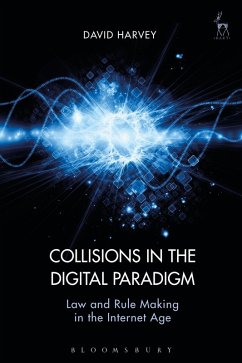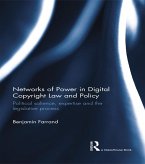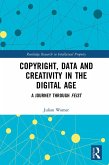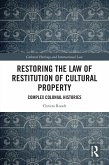David John Harvey
Collisions in the Digital Paradigm (eBook, ePUB)
Law and Rule Making in the Internet Age
33,95 €
33,95 €
inkl. MwSt.
Sofort per Download lieferbar

17 °P sammeln
33,95 €
Als Download kaufen

33,95 €
inkl. MwSt.
Sofort per Download lieferbar

17 °P sammeln
Jetzt verschenken
Alle Infos zum eBook verschenken
33,95 €
inkl. MwSt.
Sofort per Download lieferbar
Alle Infos zum eBook verschenken

17 °P sammeln
David John Harvey
Collisions in the Digital Paradigm (eBook, ePUB)
Law and Rule Making in the Internet Age
- Format: ePub
- Merkliste
- Auf die Merkliste
- Bewerten Bewerten
- Teilen
- Produkt teilen
- Produkterinnerung
- Produkterinnerung

Bitte loggen Sie sich zunächst in Ihr Kundenkonto ein oder registrieren Sie sich bei
bücher.de, um das eBook-Abo tolino select nutzen zu können.
Hier können Sie sich einloggen
Hier können Sie sich einloggen
Sie sind bereits eingeloggt. Klicken Sie auf 2. tolino select Abo, um fortzufahren.

Bitte loggen Sie sich zunächst in Ihr Kundenkonto ein oder registrieren Sie sich bei bücher.de, um das eBook-Abo tolino select nutzen zu können.
It has been said that the only asset that a lawyer has is time. But the reality is that a lawyer's greatest asset is information. The practice and the business of law is all about information exchange. The flow of information travels in a number of different directions during the life of a case. A client communicates certain facts to a lawyer. The lawyer assimilates those facts and seeks out specialised legal information which may be applicable to those facts. In the course of a generation there has been a technological revolution which represents a paradigm shift in the flow of information…mehr
- Geräte: eReader
- mit Kopierschutz
- eBook Hilfe
- Größe: 1.29MB
Andere Kunden interessierten sich auch für
![The Role of Competitors in the Enforcement of State Aid Law (eBook, ePUB) The Role of Competitors in the Enforcement of State Aid Law (eBook, ePUB)]() Fernando Pastor-MerchanteThe Role of Competitors in the Enforcement of State Aid Law (eBook, ePUB)29,95 €
Fernando Pastor-MerchanteThe Role of Competitors in the Enforcement of State Aid Law (eBook, ePUB)29,95 €![Networks of Power in Digital Copyright Law and Policy (eBook, ePUB) Networks of Power in Digital Copyright Law and Policy (eBook, ePUB)]() Benjamin FarrandNetworks of Power in Digital Copyright Law and Policy (eBook, ePUB)30,95 €
Benjamin FarrandNetworks of Power in Digital Copyright Law and Policy (eBook, ePUB)30,95 €![Copyright, Data and Creativity in the Digital Age (eBook, ePUB) Copyright, Data and Creativity in the Digital Age (eBook, ePUB)]() Julian WarnerCopyright, Data and Creativity in the Digital Age (eBook, ePUB)40,95 €
Julian WarnerCopyright, Data and Creativity in the Digital Age (eBook, ePUB)40,95 €![Law, Policy and the Internet (eBook, ePUB) Law, Policy and the Internet (eBook, ePUB)]() Law, Policy and the Internet (eBook, ePUB)46,95 €
Law, Policy and the Internet (eBook, ePUB)46,95 €![Restatement of Labour Law in Europe (eBook, ePUB) Restatement of Labour Law in Europe (eBook, ePUB)]() Restatement of Labour Law in Europe (eBook, ePUB)189,95 €
Restatement of Labour Law in Europe (eBook, ePUB)189,95 €![Not What The Bus Promised (eBook, ePUB) Not What The Bus Promised (eBook, ePUB)]() Tamara HerveyNot What The Bus Promised (eBook, ePUB)71,95 €
Tamara HerveyNot What The Bus Promised (eBook, ePUB)71,95 €![Restoring the Law of Restitution of Cultural Property (eBook, ePUB) Restoring the Law of Restitution of Cultural Property (eBook, ePUB)]() Christa RoodtRestoring the Law of Restitution of Cultural Property (eBook, ePUB)43,95 €
Christa RoodtRestoring the Law of Restitution of Cultural Property (eBook, ePUB)43,95 €-
-
-
It has been said that the only asset that a lawyer has is time. But the reality is that a lawyer's greatest asset is information. The practice and the business of law is all about information exchange. The flow of information travels in a number of different directions during the life of a case. A client communicates certain facts to a lawyer. The lawyer assimilates those facts and seeks out specialised legal information which may be applicable to those facts. In the course of a generation there has been a technological revolution which represents a paradigm shift in the flow of information and communication. Collisions in the Digital Paradigm is about how the law deals with digital information technologies and some of the problems that arise when the law has to deal with issues arising in a new paradigm.
Produktdetails
- Produktdetails
- Verlag: Bloomsbury eBooks UK
- Seitenzahl: 424
- Erscheinungstermin: 23. März 2017
- Englisch
- ISBN-13: 9781509906512
- Artikelnr.: 48015721
- Verlag: Bloomsbury eBooks UK
- Seitenzahl: 424
- Erscheinungstermin: 23. März 2017
- Englisch
- ISBN-13: 9781509906512
- Artikelnr.: 48015721
- Herstellerkennzeichnung Die Herstellerinformationen sind derzeit nicht verfügbar.
David J Harvey, formerly a District Court Judge sitting in Auckland, New Zealand, is Director of the New Zealand Center for ICT Law a part-time lecturer in Law and Information Technology, both at the Faculty of Law, University of Auckland.
1. Introduction
2. The Analytical Framework
I. Introduction
II. Elizabeth Eisenstein and the Qualities of Print
III. Digital Information
IV. Conclusion
3. The Transition to the Digital Paradigm-Analogies and Functional
Equivalence
I. Introduction
II. A Historical Perspective
III. Digital Writing
IV. Change and Communication in the Digital Paradigm
V. The Law's Approach to Equating the Old with the New
VI. Functional Equivalence
VII. The Problem of Analogies
VIII. Conclusion
4. Aspects of Internet Governance
I. Introduction
II. The Internet Governance Forum
III. Technical Governance
IV. Models of Internet Governance
V. Conclusion
5. The Property Problem
I. Introduction
II. Information as Property-The Debate in the Digital Paradigm
III. The British Commonwealth Approach
IV. The United States' Position
V. Property or Cyberproperty
VI. Conclusion
6. Recorded Law-The Twilight of Precedent in the Digital Age
I. Introduction
II. Law and Precedent in the Print and Digital Paradigms
III. The Twilight of Precedent?
7. Digital Information-The Nature of the Document and E-discovery
I. Introduction
II. The Development of E-discovery Rules
III. Common Themes in the Development of E-discovery in Asia-Pacific
Jurisdictions
IV. The Rules and Utilisation of Technology
V. Conclusion
8. Evidence, Trials, Courts and Technology
I. Introduction
II. Orality and Physical Presence of Witnesses
III. Facing Up to Change
IV. Technology in Court
V. The Next Phase
VI. Using Technology to Change Process Models
VII. Conclusion
9. Social Media
I. Introduction
II. What is Social Media?
III. Social Media Meets the Law
IV. The Googling Juror
V. Lost in Translation-Interpreting Social Media Messages
VI. Other Aspects of Social Media
VII. Conclusion
10. Information Persistence, Privacy and the Right to be Forgotten
I. Introduction
II. Privacy Themes
III. Privacy Taxonomies
IV. Obscurity of Information-Practical and Partial Obscurity
V. Judicial Approaches
VI. The Internet and Privacy
VII. Search Engines and Information Retrievability
VIII. The Right to be Forgotten
IX. A Right to Update?
X. Conclusion
11. Reputational Harms
I. Introduction
II. The Publication Issue
III. Google and Defamation
IV. Linking and Publication
V. Reputational Harms-Where Defamation Does Not Tread
VI. Triaging Reputation
VII. Conclusion
12. Conclusion
I. The Qualities of Digital Information
II. Governance of a Distributed, Dynamic, Changing Environment?
III. Behavioural Change and Values
IV. Old Rules in New Bottles-Seeking Consistency
V. Volume, Dissemination and Availability of Information
VI. Participation, Interactivity and the Message
VII. Who Am I Online?
VIII. The Message is the Medium-What the Law must Recognise
2. The Analytical Framework
I. Introduction
II. Elizabeth Eisenstein and the Qualities of Print
III. Digital Information
IV. Conclusion
3. The Transition to the Digital Paradigm-Analogies and Functional
Equivalence
I. Introduction
II. A Historical Perspective
III. Digital Writing
IV. Change and Communication in the Digital Paradigm
V. The Law's Approach to Equating the Old with the New
VI. Functional Equivalence
VII. The Problem of Analogies
VIII. Conclusion
4. Aspects of Internet Governance
I. Introduction
II. The Internet Governance Forum
III. Technical Governance
IV. Models of Internet Governance
V. Conclusion
5. The Property Problem
I. Introduction
II. Information as Property-The Debate in the Digital Paradigm
III. The British Commonwealth Approach
IV. The United States' Position
V. Property or Cyberproperty
VI. Conclusion
6. Recorded Law-The Twilight of Precedent in the Digital Age
I. Introduction
II. Law and Precedent in the Print and Digital Paradigms
III. The Twilight of Precedent?
7. Digital Information-The Nature of the Document and E-discovery
I. Introduction
II. The Development of E-discovery Rules
III. Common Themes in the Development of E-discovery in Asia-Pacific
Jurisdictions
IV. The Rules and Utilisation of Technology
V. Conclusion
8. Evidence, Trials, Courts and Technology
I. Introduction
II. Orality and Physical Presence of Witnesses
III. Facing Up to Change
IV. Technology in Court
V. The Next Phase
VI. Using Technology to Change Process Models
VII. Conclusion
9. Social Media
I. Introduction
II. What is Social Media?
III. Social Media Meets the Law
IV. The Googling Juror
V. Lost in Translation-Interpreting Social Media Messages
VI. Other Aspects of Social Media
VII. Conclusion
10. Information Persistence, Privacy and the Right to be Forgotten
I. Introduction
II. Privacy Themes
III. Privacy Taxonomies
IV. Obscurity of Information-Practical and Partial Obscurity
V. Judicial Approaches
VI. The Internet and Privacy
VII. Search Engines and Information Retrievability
VIII. The Right to be Forgotten
IX. A Right to Update?
X. Conclusion
11. Reputational Harms
I. Introduction
II. The Publication Issue
III. Google and Defamation
IV. Linking and Publication
V. Reputational Harms-Where Defamation Does Not Tread
VI. Triaging Reputation
VII. Conclusion
12. Conclusion
I. The Qualities of Digital Information
II. Governance of a Distributed, Dynamic, Changing Environment?
III. Behavioural Change and Values
IV. Old Rules in New Bottles-Seeking Consistency
V. Volume, Dissemination and Availability of Information
VI. Participation, Interactivity and the Message
VII. Who Am I Online?
VIII. The Message is the Medium-What the Law must Recognise
1. Introduction
2. The Analytical Framework
I. Introduction
II. Elizabeth Eisenstein and the Qualities of Print
III. Digital Information
IV. Conclusion
3. The Transition to the Digital Paradigm-Analogies and Functional
Equivalence
I. Introduction
II. A Historical Perspective
III. Digital Writing
IV. Change and Communication in the Digital Paradigm
V. The Law's Approach to Equating the Old with the New
VI. Functional Equivalence
VII. The Problem of Analogies
VIII. Conclusion
4. Aspects of Internet Governance
I. Introduction
II. The Internet Governance Forum
III. Technical Governance
IV. Models of Internet Governance
V. Conclusion
5. The Property Problem
I. Introduction
II. Information as Property-The Debate in the Digital Paradigm
III. The British Commonwealth Approach
IV. The United States' Position
V. Property or Cyberproperty
VI. Conclusion
6. Recorded Law-The Twilight of Precedent in the Digital Age
I. Introduction
II. Law and Precedent in the Print and Digital Paradigms
III. The Twilight of Precedent?
7. Digital Information-The Nature of the Document and E-discovery
I. Introduction
II. The Development of E-discovery Rules
III. Common Themes in the Development of E-discovery in Asia-Pacific
Jurisdictions
IV. The Rules and Utilisation of Technology
V. Conclusion
8. Evidence, Trials, Courts and Technology
I. Introduction
II. Orality and Physical Presence of Witnesses
III. Facing Up to Change
IV. Technology in Court
V. The Next Phase
VI. Using Technology to Change Process Models
VII. Conclusion
9. Social Media
I. Introduction
II. What is Social Media?
III. Social Media Meets the Law
IV. The Googling Juror
V. Lost in Translation-Interpreting Social Media Messages
VI. Other Aspects of Social Media
VII. Conclusion
10. Information Persistence, Privacy and the Right to be Forgotten
I. Introduction
II. Privacy Themes
III. Privacy Taxonomies
IV. Obscurity of Information-Practical and Partial Obscurity
V. Judicial Approaches
VI. The Internet and Privacy
VII. Search Engines and Information Retrievability
VIII. The Right to be Forgotten
IX. A Right to Update?
X. Conclusion
11. Reputational Harms
I. Introduction
II. The Publication Issue
III. Google and Defamation
IV. Linking and Publication
V. Reputational Harms-Where Defamation Does Not Tread
VI. Triaging Reputation
VII. Conclusion
12. Conclusion
I. The Qualities of Digital Information
II. Governance of a Distributed, Dynamic, Changing Environment?
III. Behavioural Change and Values
IV. Old Rules in New Bottles-Seeking Consistency
V. Volume, Dissemination and Availability of Information
VI. Participation, Interactivity and the Message
VII. Who Am I Online?
VIII. The Message is the Medium-What the Law must Recognise
2. The Analytical Framework
I. Introduction
II. Elizabeth Eisenstein and the Qualities of Print
III. Digital Information
IV. Conclusion
3. The Transition to the Digital Paradigm-Analogies and Functional
Equivalence
I. Introduction
II. A Historical Perspective
III. Digital Writing
IV. Change and Communication in the Digital Paradigm
V. The Law's Approach to Equating the Old with the New
VI. Functional Equivalence
VII. The Problem of Analogies
VIII. Conclusion
4. Aspects of Internet Governance
I. Introduction
II. The Internet Governance Forum
III. Technical Governance
IV. Models of Internet Governance
V. Conclusion
5. The Property Problem
I. Introduction
II. Information as Property-The Debate in the Digital Paradigm
III. The British Commonwealth Approach
IV. The United States' Position
V. Property or Cyberproperty
VI. Conclusion
6. Recorded Law-The Twilight of Precedent in the Digital Age
I. Introduction
II. Law and Precedent in the Print and Digital Paradigms
III. The Twilight of Precedent?
7. Digital Information-The Nature of the Document and E-discovery
I. Introduction
II. The Development of E-discovery Rules
III. Common Themes in the Development of E-discovery in Asia-Pacific
Jurisdictions
IV. The Rules and Utilisation of Technology
V. Conclusion
8. Evidence, Trials, Courts and Technology
I. Introduction
II. Orality and Physical Presence of Witnesses
III. Facing Up to Change
IV. Technology in Court
V. The Next Phase
VI. Using Technology to Change Process Models
VII. Conclusion
9. Social Media
I. Introduction
II. What is Social Media?
III. Social Media Meets the Law
IV. The Googling Juror
V. Lost in Translation-Interpreting Social Media Messages
VI. Other Aspects of Social Media
VII. Conclusion
10. Information Persistence, Privacy and the Right to be Forgotten
I. Introduction
II. Privacy Themes
III. Privacy Taxonomies
IV. Obscurity of Information-Practical and Partial Obscurity
V. Judicial Approaches
VI. The Internet and Privacy
VII. Search Engines and Information Retrievability
VIII. The Right to be Forgotten
IX. A Right to Update?
X. Conclusion
11. Reputational Harms
I. Introduction
II. The Publication Issue
III. Google and Defamation
IV. Linking and Publication
V. Reputational Harms-Where Defamation Does Not Tread
VI. Triaging Reputation
VII. Conclusion
12. Conclusion
I. The Qualities of Digital Information
II. Governance of a Distributed, Dynamic, Changing Environment?
III. Behavioural Change and Values
IV. Old Rules in New Bottles-Seeking Consistency
V. Volume, Dissemination and Availability of Information
VI. Participation, Interactivity and the Message
VII. Who Am I Online?
VIII. The Message is the Medium-What the Law must Recognise







